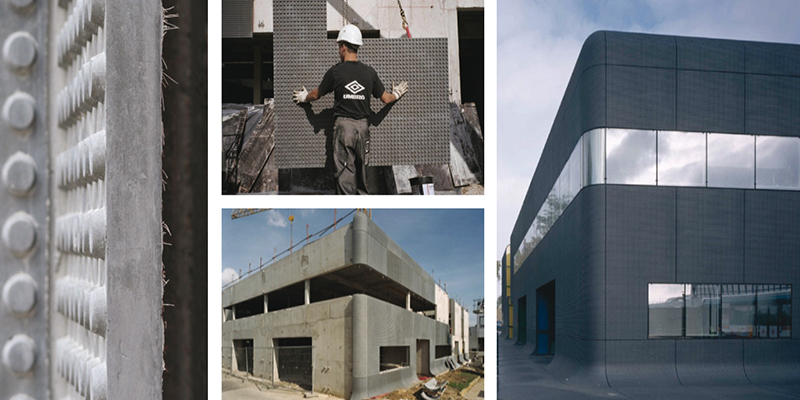Downloads
DOI:
https://doi.org/10.7480/jfde.2015.1.922Keywords:
Composite panels, ultra-high performance concrete (UHPC), autoclaved aerated concrete (AAC), cellular lightweight concrete (CLC), aerogel, modified earth plasterAbstract
The awareness of the environmental impact of the building sector is increasing. Steel reinforced concrete is the most commonly used construction material, though with a high-embodied energy and carbon footprint. Large environmental gains may arise if an alternative to steel reinforced concrete is developed. In this context, ultra-high performance concrete (UHPC) materials are shown to be promising alternatives with advantages such as lower embodied energy and reduced environmental impact. Predictions suggest that UHPC composite elements for building envelopes could have other benefits such as an increased service life, optimised use of building area due to thinner elements and minimised maintenance due to the absence of reinforcement or use of non-corrosive reinforcing materials such as carbon fibres. In the framework of the H-HOUSE project funded by the European Commission, composite elements are developed. The aim is to create facade panels combining an autoclaved aerated concrete or cellular lightweight concrete insulation layer with an external UHPC supporting layer. To enhance occupant comfort and health, hygroscopic materials that are capable to buffer indoor air humidity shall be applied to the inside of such elements. Indoor air humidity levels are expected to be more stable, which shall subsequently improve the indoor climate and minimise potential decay to the construction.
How to Cite
Published
Issue
Section
License
Copyright (c) 2015 Lorenzo Miccoli, Patrick Fontana, Nelson Silva, Andrea Klinge, Christer Cederqvist, Oliver Kreft, Dirk Qvaeschning, Christer Sjostrom

This work is licensed under a Creative Commons Attribution 4.0 International License.
Authors or their institutions retain copyright to their publications without restrictions.
References
Acker, P. & Behloul, M. (2004). Ductal® technology: A large spectrum of properties, a wide range of applications. In: Proc. Int. Symp. On Ultra High Performance Concrete, September 13-15, 2004, Kassel, Germany, 11-23.
Ahlborn, T. M., Miss-on, D. L., Peuse, E. J., & Gilbertson, C. G. (2008). Durability and Strength Characterization of Ultra-High Performance Concrete under variable Curing Regimes. In: Proc. 2nd Int. Symp. on Ultra High Performance Concrete, Fehling, E., Schmidt, M., & Stürwald, S. (Eds.) Kassel, Germany, March 5-7, 2008, Schriftenreihe Baustoffe und Massivbau (10), Kassel University Press, 197-204.
Alexanderson, J. (1979). Relations between structure and mechanical properties of autoclaved aerated concrete. Cem. Concr. Res. 9(4), 507-514.
Behloul, M., & Batoz, J. -F. (2008). Ductal® applications over the last Olympiad. In: Proc. 2nd Int. Symp. on Ultra High Performance Concrete, Kassel, Germany, March 5-7, 2008, Schriftenreihe Baustoffe und Massivbau (10), Kassel University Press, 855-862.
Bus Center RATP in Thiais, France (www.szolyd.com).
De Larrard, F., & Sedran, T. (1994). Optimization of ultra-high-performance concrete by the use of a packing model. Cement and Concrete Research, 24, 997-1009.
DIN 18947 (2013). Earth Plasters – Terms and definitions, requirements, test methods.
EN ISO 10456 (2010), Building materials and products – Procedures for determining declared and design thermal values.
EN 1992-1-1 (2004). Eurocode 2: Design of concrete structures – Part 1-1 – Part 3.
EN 197-1 (2011). Cement. Composition, specifications and conformity criteria for common cements.
European Technical Approval, ETA-05/0093 (2011). Multipor thermal insulation panel, valid to June 1, 2019.
Lippe, K. L. (1986). Entwicklung hochporöser C-S-H- Werkstoffe mit minimaler Wärmeleitfähigkeit. BMFT Forschung Band 86, Fachinformationszentrum Energie/Physik/ Mathematik.
Narayanan, N., & Ramamurthy K. (2000). Structure and properties of aerated concrete: a review. Cement & Concrete Composites. 22, 321-329.
Oel, H. J. (1980). Wärmeleitfähigkeit und Festigkeit von Calzium-Hydrosilicat-Produkten. Abschlußbericht DFG Forschungsvorhaben Mo 256/6.
Piérard, J., Dooms, B., & Cauberg, N. (2012). Evaluation of Durability Parameters of UHPC Using Accelerated Lab Tests. In: Schmidt, M. et al. (Eds.): Proc. of Hipermat 2012, 3rd Int. Symp. On UHPC and Nanotechnology for High Performance Construction Materials, March 7-9, 2012, Kassel, Germany, 371-376.
Rebentrost, M., & Wight, G. (2008a). Experiences and applications on Ultra-high Performance Concrete in Asia. In: Proc. 2nd Int. Symp. On Ultra High Performance Concrete, Fehling, E., Schmidt, M. and Stürwald, S. (Eds.), Kassel, Germany, March 5-7, 2008, Schriftenreihe Baustoffe und Massivbau (10), Kassel University Press, 19-30.
Rebentrost, M. & Wight, G. (2008b). Behaviour and Resistance of Ultra High Performance Concrete to Blast Effects. In: Proc. 2nd Int. Symp. On Ultra High Performance Concrete, Kassel, Germany, March 5-7, 2008, 735-742.
Thomas, M., Green, B., O’Neal, E., Perry, V., Hayman, S., & Hossack, A. (2012). Marine performance of UHPC at Treat Island. In: Schmidt, M. et al. (eds.): Proc. of Hipermat 2012, 3rd Int. Symp. On UHPC and Nanotechnology for High Performance Construction Materials, March 7-9, 2012, Kassel, Germany, 365-370.
